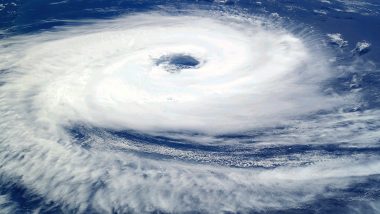Two weeks after the landfall of Cyclone Amphan, India is gearing up for yet another possible Cyclone in the Arabian Sea, cyclone Nisarga where the current events are hinting a detectable increase in Cyclonic trends in pre monsoon season.
Observing the pattern of Cyclone Amphan that ravaged the coasts of West Bengal, Odisha and Bangladesh and the possible emergence of Nisarga Cyclone, that is yet to hit Maharashtra and Gujarat between June 2-4, climate scientists say that with rapidly warming Indian Ocean, the severity and frequency of Cyclones is increasing in Western and Eastern coasts of India. Cyclone Nisarga Intensifies, PM Narendra Modi Reviews Preparedness in Parts of India’s Western Coast, Prays for Everyone’s Well-Being.
Relation Between Temperature and Storm Strength
Cyclones are fuelled by available heat where warming seas can make Cyclones more powerful by increasing their speed. Dr Roxy Mathew Koll, Scientist at Indian Institute of Tropical Meteorology said,“In the case of both the recent cyclones — Amphan and now Nisarga, the anomalously warm ocean temperatures are proving to give them a major boost. While temperatures in the Bay of Bengal were between 30-33°C prior to Amphan, surface temperatures over the Arabian Sea were recorded 30-32°C prior to the depression, which is now evolving as cyclone Nisarga. Such high temperatures aid rapid intensification of these cyclonic systems, which many weather models fail to capture.”
How the Warming Indian Ocean is Affecting Coasts of India
Almost all tropical Cyclonic storms are concentrated in East Asia, North America and Central American regions. The North Indian Ocean and Bay of Bengal account for 7% of world’s cyclones however their impact is comparatively high and more devastating.
Explaining about the pattern of increase in pre-monsoon tropical cyclones over Arabian Sea Dr. Roxy said, “ IPCC reports indicate an increase in Arabian Sea cyclones during the pre-and post-monsoon seasons as a response to the rapid ocean warming trends.” Nisarga Cyclone Gains Momentum, Mumbai, Raigad, Palghar, Valsad, Navsari, Surat Among Districts Likely to be Affected.
On changing characteristics of the Arabian sea, Dr Anjal Prakash, Coordinating Lead Author of IPCC’s Oceans and Cryosphere report stated that the “impact of the warming of the Indian ocean means that there would be an increase in the incidences of tropical cyclone winds and rainfall. It will lead to an increase in extreme waves, combined with relative sea-level rise, exacerbate extreme sea-level events and coastal hazards. One of the most affected cities, as per the IPCC reports, is Mumbai.”
As Nisarga is expected to hit the western coast, metro cities like Mumbai are under severe threat. Multiple studies claim that India’s largest coastal cities, like Mumbai and Kolkata, are facing the severest threats from climate-induced flooding. What makes them further vulnerable is unplanned development in most ecologically sensitive zones.
More Intense Rainfall Due to Climate Change
Earth’s atmosphere is rapidly increasing due to global warming, a product of release in carbon emission. The warmer atmosphere can hold more water, driving extreme rainfall during pre- monsoon time and can cause floods. Nisarga Cyclone Tracker: Cyclonic Storm to Turn Into Severe Cyclonic Storm by June 3; Check Forecast and Day-Wise Movement.
Besides Amphan and Nisarga that brought and are expected to lead to isolated rains in India, some of the instances of heavy downpour brought due to Cyclones include- Rains in Bangladesh in March 2017, which led to flooding; Hurricane Harvey that caused catastrophic flooding in Texas in 2017; US hurricanes, Katrina, Irma and Maria causing rains; the strong 2015 cyclone season in the Western North Pacific.
(The above story first appeared on LatestLY on Jun 02, 2020 03:46 PM IST. For more news and updates on politics, world, sports, entertainment and lifestyle, log on to our website latestly.com).













 Quickly
Quickly





















